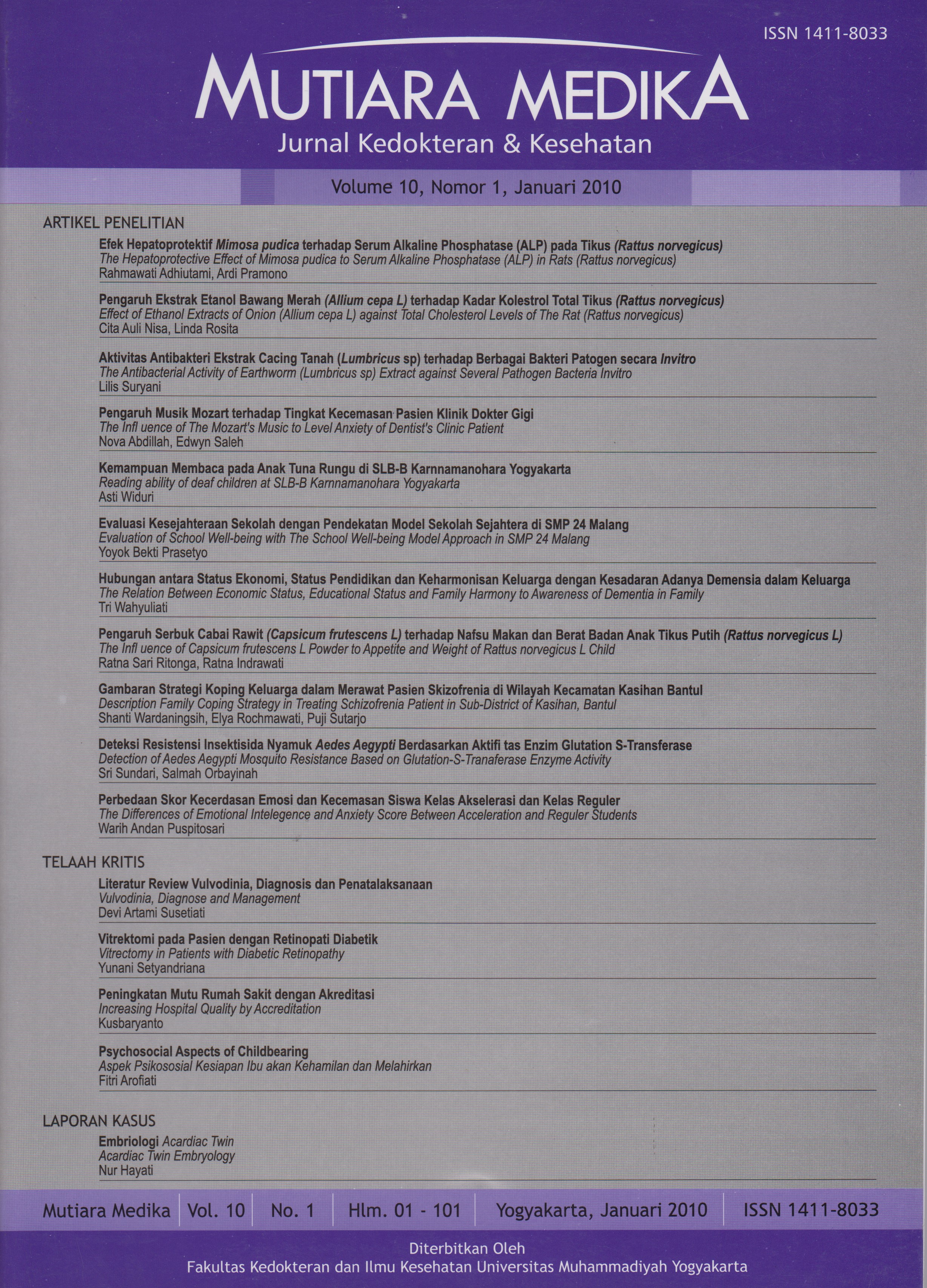Deteksi Resistensi Insektisida Nyamuk Aedes Aegypti Berdasarkan Aktifitas Enzim Glutation S-Transferase
DOI:
https://doi.org/10.18196/mmjkk.v10i1.1563Keywords:
Aedes Aegypti, Glutation-S-transferase, resistensi insektisida, gluthation s-tranferase, insecticide resistanceAbstract
Organophosphate insecticide especially temephos and malathion have been used to eliminate mosquito and larvae Aedes aegypti in Yogyakarta province since 1974 up to now. Using by unappropriate chemical insecticide in long term causes resistance of mosquito to the insecticide. It indicates the increasing of Glutation-S-transferase and hydrolyses activity.The biochemical research method conducted at 1995 in Yogyakarta demonstrsted that mosquito and larvae Ae.aegypti based on enzyme esterase activity tend to be resist to organophosphate insecticide. The purpose of this research is to evaluate the resistance status of Ae. Aegypti mosquito to malathion insecticide in some villages in Bantul district based on Glutation-S- transferase activity. This research design was cross sectional study . Sample was collected randomly from these villages : Badegan, Palbapang and Bogoran in Bantul District. There were 48 mosquitos taken for examination of Glutation-S-tranferase activity.The result of examination based on Glutation-S-tranferase activity showed that the average of Ae. Aegypti mosquito resistance in three villages of Bantul District such as: moderate resistance (RS) 15%, susceptible (SS) 85%. However, statitiscally, there was no significant difference of resistance status of mosquito among three villages based on Glutation-S-tranferase (p>0,05).
Insektisida kimia organofosfat (OP), khususnya temefos dan malathion selalu dipakai untuk memberantas Aedes aegypti stadium dewasa dan larva di Daerah Istimewa Yogyakarta sejak tahun 1974. Penggunaan insektisida dengan dosis yang kurang tepat dalam jangka waktu yang lama akan menyebabkan resistensi nyamuk terhadap insektisida. Keadaan ini akan ditandai dengan peningkatan aktifitas enzim Glutation-S-transferase dan hidrolase. Penelitian yang dilakukan pada tahun 1995 melaporkan bahwa sudah terjadi kecenderungan resistensi nyamuk dan larva Ae. Aegypti terhadap organofosfat di Yogyakarta yang didasarkan pada aktifitas enzim esterase. Tujuan penelitian ini adalah untuk mengetahui tingkat resistensi nyamuk Ae. Aegypti di beberapa wilayah Bantul yang didasarkan pada aktifitas enzim Glutation-S- transferase. Penelitian ini merupakan penelitian analitik nonparamerik dengan desain cross sectional. Penentuan sampel dengan sampel random sampling dari 3 wilayah di Kabupaten Bantul yaitu Badegan, Palbapang dan Bogoran. Dari masing- masing wilayah diambil 48 nyamuk yang dilakukan pemeriksaan Glutation-S- transferase. Hasil penelitian yang didasarkan aktifitas ensim Glutation-S- transferase menunjukkan bahwa rata-rata tingkat resistensi nyamuk di 3 wilayah Kabupaten Bantul adalah sebagai berikut: resistensi sedang (RS) 15%, rentan (SS) 85%. Dari hasil analsis statistis diperolah hasil bahwa tidak ada perbedaan yang bermakna status resistensi nyamuk berdasarkan aktifitas Glutation-S- transferase di 3 wilayah tersebut (p>0,05).
References
Mardihusodo, S.J., 1995. Deteksi Resistensi Insektisida Organofosfat pada Nyamuk Ae. Aegypti Linn. Dengan Metode uji Noda Kertas Saring. Lembaga Penelitian Universitas Gadjah Mada, 3-17
Hoedojo. 1993. Sektor Demam Berdarah dan Penanggulangannya Majalah Parasitlogi Indonesia 6, Jakarta, hal 32-42.
Weill M., Berthomeu A., Berticat C., Lutfalla G., Negre V., Pasteur N., Philips A., Leonetti J.P., Fort P., and Raymond M. 2004. Insecticide reistance: a silent base prediction, Current Biology, Vol.14, No. 14:552-553
Pratiknya, W. 1986. Dasar-Dasar Metodologi Penelitian Kedokteran dan Kesehatan, C.V. Rajawali. Jakarta
Habig, W.H., Pabst, M.J., and Jakoby, W.B. 1974. Glutathione-S-Transferase The first Enzymatic Step in Mercapturic Acid Formation, J. Biol. Chem. 249: 7130-7139.
Board, PG., Baker, R.T.,Chelvanayagam, G., and Jermin, L.S.1997. Zeta, a novel class of glutathione S-transferase in a range of species from plants to human, Biochem. J., 328: 929-935.
Sudibyo. 1997. Penelusuran Senyawa Kandungan Tumbuhaan Insektisida Indonesia Bioaktif terhadap Serangga, Disertasi Universitas Padjajaran, Bandung.
Clark, A.G., Hamilton, J.F., and Marshall, S.N. 1991. Inhibition by inorganic anions of glutathione S-transferase from insect and mammalian sources, Biochem. J., 278: 193-198.
Habig, W.H. and Jakoby, W.B. 1981. Assays for differentiation of glutathione S-transferase, Methods of Enzymol., 77: 398-403..
Van Der Aar. 1997. Structure- activity relationships and active site characterization of glutathione S-transferase, Ph.D Thesis, Division of Molecular Toxicology, Department of Pharmacochemistry, LACDR-Vrije ll, Amsterdam.
Downloads
Published
Issue
Section
License
Copyright
Authors retain copyright and grant Mutiara Medika: Jurnal Kedokteran dan Kesehatan (MMJKK) the right of first publication with the work simultaneously licensed under an Attribution 4.0 International (CC BY 4.0) that allows others to remix, adapt and build upon the work with an acknowledgment of the work's authorship and of the initial publication in Mutiara Medika: Jurnal Kedokteran dan Kesehatan (MMJKK).
Authors are permitted to copy and redistribute the journal's published version of the work (e.g., post it to an institutional repository or publish it in a book), with an acknowledgment of its initial publication in Mutiara Medika: Jurnal Kedokteran dan Kesehatan (MMJKK).
License
Articles published in the Mutiara Medika: Jurnal Kedokteran dan Kesehatan (MMJKK) are licensed under an Attribution 4.0 International (CC BY 4.0) license. You are free to:
- Share — copy and redistribute the material in any medium or format.
- Adapt — remix, transform, and build upon the material for any purpose, even commercially.
This license is acceptable for Free Cultural Works. The licensor cannot revoke these freedoms as long as you follow the license terms. Under the following terms:
Attribution — You must give appropriate credit, provide a link to the license, and indicate if changes were made. You may do so in any reasonable manner, but not in any way that suggests the licensor endorses you or your use.
- No additional restrictions — You may not apply legal terms or technological measures that legally restrict others from doing anything the license permits.






